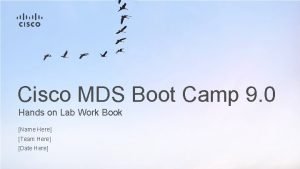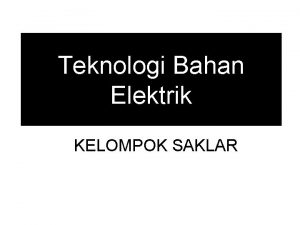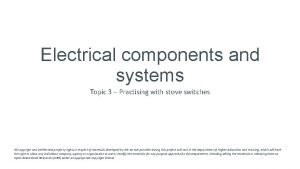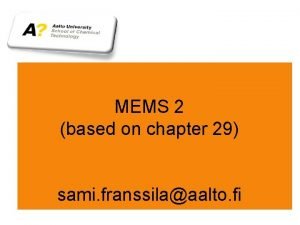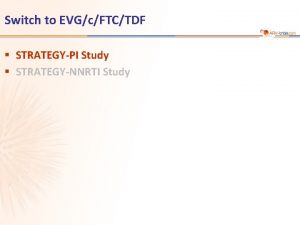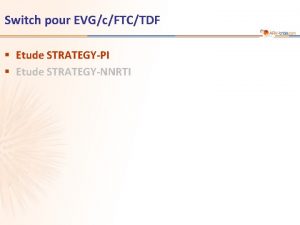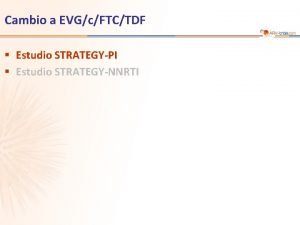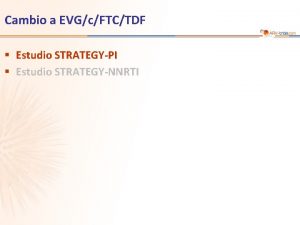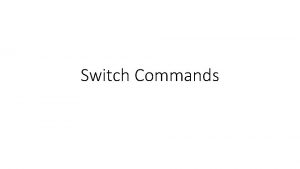Switch to EVGcFTCTDF STRATEGYPI Study STRATEGYNNRTI Study STRATEGYNNRTI









- Slides: 9

Switch to EVG/c/FTC/TDF § STRATEGY-PI Study § STRATEGY-NNRTI Study

STRATEGY-NNRTI Study: Switch NNRTI to EVG/c § Design Randomisation* 2: 1 Open-label HIV+ ≥ 18 years On FTC + TDF + NNRTI HIV RNA < 50 c/m. L > 6 months No virologic failure Genotype testing before ART with no resistance to study drugs Integrase inhibitor naïve e. GFR > 70 m. L/mim § Endpoints N = 292 N = 147 W 48 W 96 Switch to EVG/c/FTC/TDF Continue NNRTI + FTC + TDF * Randomisation stratified by EFV use at screening – Primary: proportion of patients maintaining HIV RNA < 50 c/m. L at W 48 (m. ITT, snapshot) ; non-inferiority if lower margin of a two-sided 95% CI for the difference = -12%, 85% power. If non-inferiority and lower margin > 0, assessment for superiority – Secondary: proportion of patients maintaining HIV RNA < 50 c/m. L at W 48 (TLOVR algorithm), CD 4, safety, tolerability to W 96 STRATEGY-NNRTI Pozniak A. Lancet Infect Dis 2014; 14: 590 -9

STRATEGY-NNRTI Study: Switch NNRTI to EVG/c Baseline characteristics and patient disposition EVG/c/FTC/TDF N = 291 NNRTI + FTC + TDF N = 143 Median age, years 43 39 Female 8% 6% 5 5 90% 91% 80% (76%) 74% (70%) Nevirapine 16% 19% Rilpivirine 3% 7% Etravirine 1% 0 561 562 2% / 4% 2% / 1% 22 18 Time since HIV diagnosis, median years On first ARV regimen NNRTI at randomisation Efavirenz (coformulated EFV/FTC/TDF) CD 4 cell count (/mm 3), median Hepatitis B / hepatitis C coinfection Discontinuation by W 48 STRATEGY-NNRTI Pozniak A. Lancet Infect Dis 2014; 14: 590 -9

STRATEGY-NNRTI Study: Switch NNRTI to EVG/c Virologic outcome at W 48 (m. ITT, snapshot) EVG/c/FTC/TDF NNRTI + FTC + TDF HIV RNA < 50 c/m. L % 100 HIV RNA ≥ 50 c/m. L No virologic data 93 88 80 60 40 20 1 0 Difference (95% CI) = 5. 3% (-0. 5 to 12. 0) STRATEGY-NNRTI 6 11 1 N=3 N=1 Pozniak A. Lancet Infect Dis 2014; 14: 590 -9

STRATEGY-NNRTI Study: Switch NNRTI to EVG/c HIV RNA < 50 c/m. L Sensitivity and secondary analysis Per-proctol EGV/c/FTC/TDF NNRTI + FTC + TDF 99% Difference: 0. 1% (95% CI: - 2. 1 to 3. 5) ITT-TLOVR 92% 87% Difference: 5. 0% (95% CI: -1. 1 to 12. 1) § One participant in each group met the criteria for resistance testing (HIV RNA > 400 c/m. L at virologic failure or early discontinuation) – No emergence of resistance – Both remained on study treatment and achieved HIV RNA < 50 c/m. L after W 48 STRATEGY-NNRTI Pozniak A. Lancet Infect Dis 2014; 14: 590 -9

STRATEGY-NNRTI Study: Switch NNRTI to EVG/c Virologic sucess overall and by subgroup at W 48 (m. ITT) n/N Overall 271/290 126/143 Age < 40 years 107/114 62/74 Age > 40 years 164/176 64/69 Male 251/267 119/134 Female 20/23 7/9 White 216/230 99/109 Non-white 55/60 27/34 Efavirenz 214/231 91/106 Non-efavirenz 57/59 35/37 On first regimen at baseline On second regimen at baseline 245/262 114/130 25/27 11/12 0 STRATEGY-NNRTI 10 20 30 40 50 60 70 80 90 100 Virological success (%) Switch group No-switch group -20 -10 Favours not switching 0 10 20 30 40 Difference (%) Favours switching 50 Pozniak A. Lancet Infect Dis 2014; 14: 590 -9

STRATEGY-NNRTI Study: Switch NNRTI to EVG/c Adverse events and grade 3 -4 laboratory abnormalities EVG/c/FTC/TDF NNRTI + FTC + TDF 81% 75% 7% 6% 5% 4% N = 6 (2%)* N = 1 (1%)** Death N=1 0 AE occurring more frequently in one group 14% 23% Headache (p = 0. 03) 3% 1% Nausea (p = 0. 05) 2% 6% Cough (p= 0. 04) 2% 1% Fatigue (p = 0. 02) 2% 1% Any adverse event, Grade 3 or 4 AE Serious adverse event Discontinuation because of AE * neuromuscular symptoms, suicide, dysgueusia, prurigo, Fanconi syndrome, increased creatinine ** altered mood STRATEGY-NNRTI Pozniak A. Lancet Infect Dis 2014; 14: 590 -9

STRATEGY-NNRTI Study: Switch NNRTI to EVG/c § Other safety data – Incidence and prevalence of headache and nausea became similar between groups by week 12 – Grade 3 -4 laboratory abnormalities : 10% in the switch group vs 14% in the no-switch group – Creatinine increase in switch group at week 4, stabilizing up to week 48 (median +11 mmol/L) – Small decrease in HDL-cholesterol in the switch group vs no change in the no-switch group – In the subgroup switched form EFV + FTC + TDF to EVG/c/FTC/TDF • Improvement in lipids • HIV Symptom Index : improvement of CNS symptoms • Higher treatment satisfaction score at W 4 and W 24 STRATEGY-NNRTI Pozniak A. Lancet Infect Dis 2014; 14: 590 -9

STRATEGY-NNRTI Study: Switch NNRTI to EVG/c § Conclusion – Coformulated EVG/c/FTC/TDF is non-inferior to continuing an existing regimen of NNRTI plus FTC and TDF in virologically suppressed, HIVinfected adults with no history of virological failure or resistance to FTC or TDF. – Low frequency of virologic failure and absence of emergent resistance in the group switched to EVG/c/FTC/TDF – Rare discontinuations because of adverse events – Fatigue, cough, headache and nausea were more frequent in the switch group ; – Rates of CNS symptoms decreased in patients switched from EFV – Increase in creatinine similar to that of phase 3 of EGV/c/FTC/TDF – Moderate improvement in lipids in patients switched from EFV – EVG/c/FTC/TDF is a switch option in virologically suppressed patients with no history of virological failure on an NNRTI regimen, when its continuation is not suitable STRATEGY-NNRTI Pozniak A. Lancet Infect Dis 2014; 14: 590 -9



